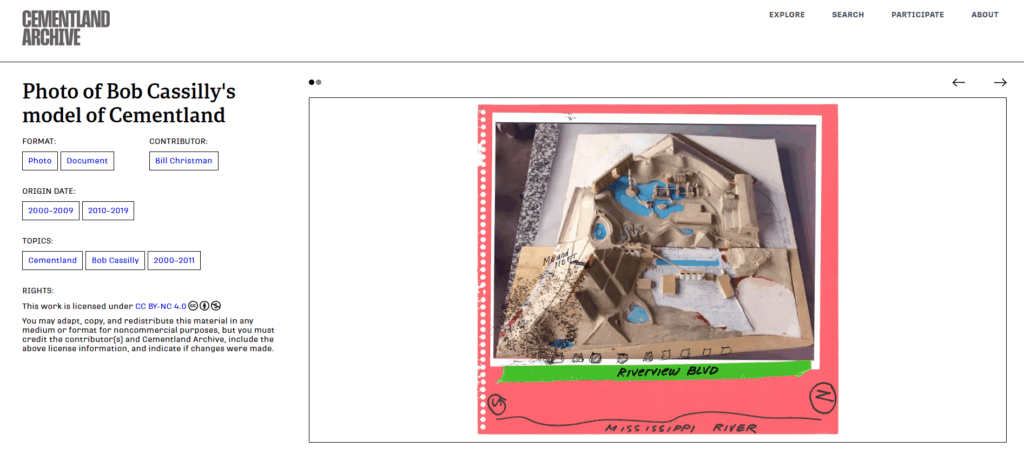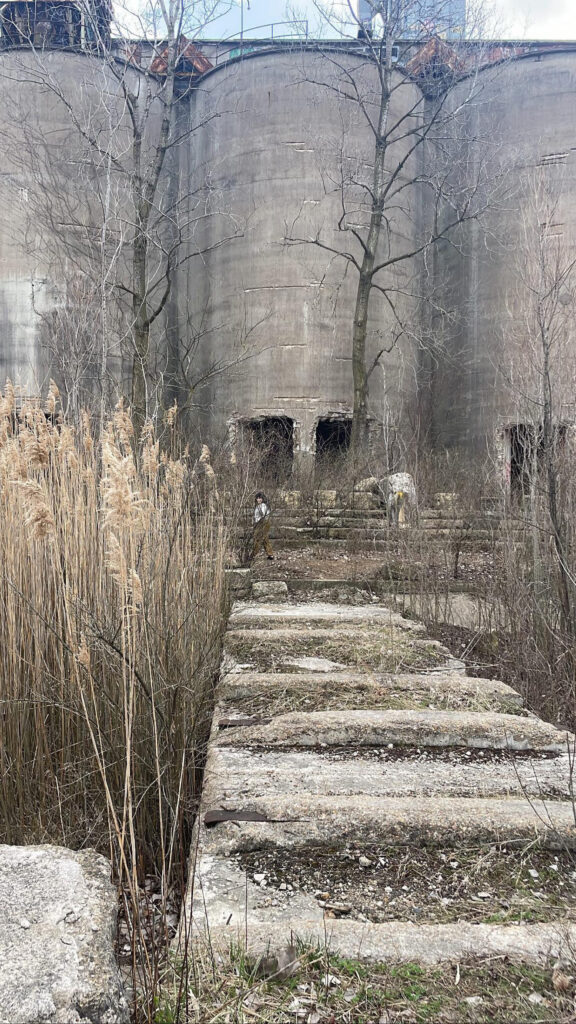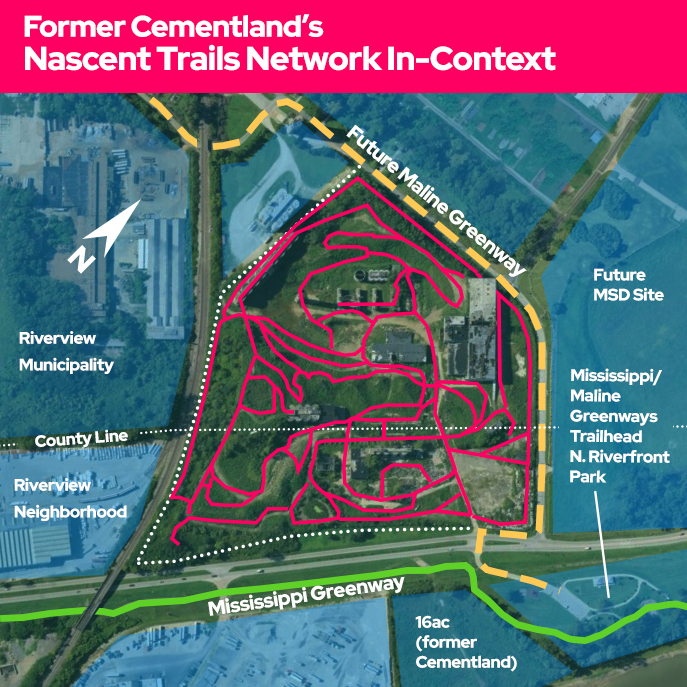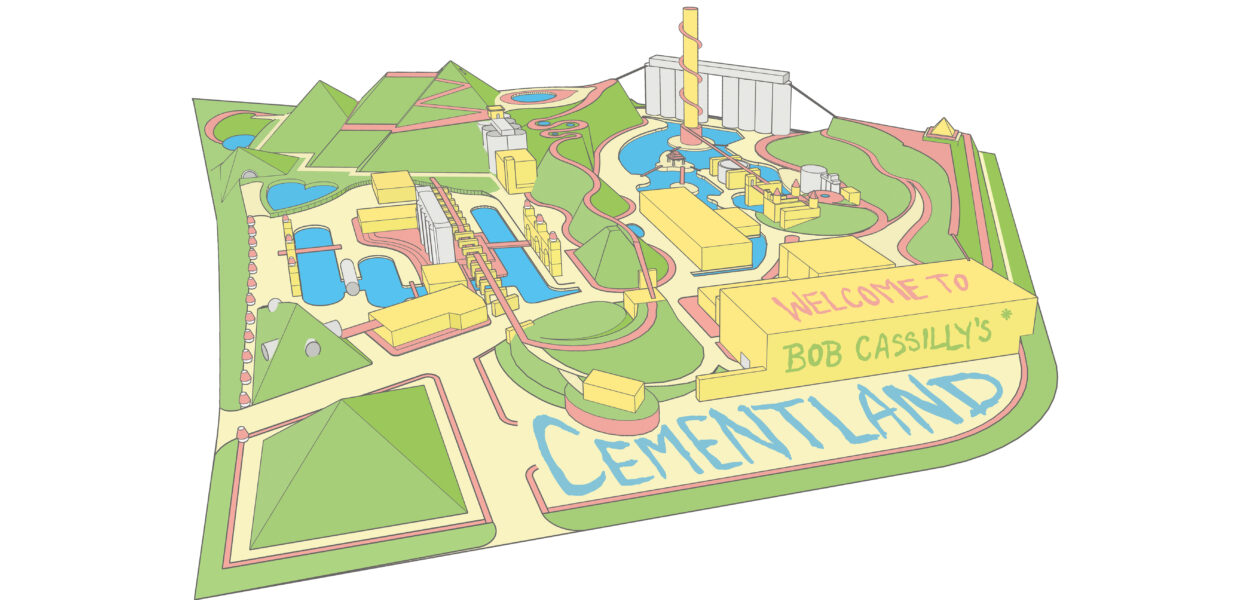Late last year I stumbled upon a photograph – a scale model of Cementland made by City Museum visionary Bob Cassilly as an in-progress representation of the core 40 acres of the then-56-acre Riverview Neighborhood/Riverview Municipality site. I had always heard that any plans for Cementland were entirely in Bob’s head, and thus any direction for the completion of the site died, tragically, with Bob in 2011. The existence of a scale model, or a photograph of such, donated to the Cementland Archive by Cassily’s friend Bill Christman, suggested another story. Here was an overarching plan– some incomplete vision to point to – even if it was no bigger than a pizza box.
Cementland Archive

Cementland Archive is the brainchild of Daniil Gerasimova and Liz Van Horn, two WashU alums who moved to the area in 2018 and became interested in the site’s tangled history. They received a grant from Luminary Arts in 2023 to create the web archive and compile interviews, art, photographs, and related media telling the story of Cementland from its inception to Cassilly’s tragic death and – crucially – beyond. The site now hosts over 150 entries, extensively tagged and catalogued by format, source, date, and topic.
In addition to the website, the archive’s creators are producing a zine, likely to be released later this year, curating some of the archive’s content and outlining approaches to engaging with works within the archive. I got in touch with the site’s creators and pitched creating a 3D model and color illustration (above) based on the scale model they’d featured. I wanted to create an image that might capture something of what Cementland could have been once completed. To create this I used the image of the scale model, satellite imagery of the site from 2012 after work appears to have stopped, and numerous photographs both from Cementland Archive and elsewhere across the web.

Through collecting reference images, I discovered that Cementland was further along than I’d previously imagined. Much of the major sculpting of the land had been completed, canals and waterways had been dug and connected between the site’s halves east to west, detailed stone buildings and brick paths were emerging near the site’s western end. The vision had quite literally begun to take shape.
Together, these references took me near to the point of completing the illustration. However, large portions of the site nearest Riverview Drive were being used to store materials when work stopped. These areas of the scale model were incomplete as well. Lacking further information, but determined not to simply leave these spaces empty, I attempted to infer and imagine what might have been in store here, noting Cassilly’s obsessions throughout – castles, pyramids, and ancient ruins connected by a network of catwalks, trails, tunnels, and waterways – even going so far as to incorporate large scale material resources I could see from the satellite imagery.
Admittedly it’s a tricky business to add one’s own elements to an unfinished work. I was never involved with the site, nor do I have any special knowledge of the project. My connection is that of many St. Louisans – we marvelled at City Museum, we cheered on the creation of Cementland, and we grieved Cassilly’s death and the project’s demise. But, that grieving is not over. The story of Cementland, like the incomplete project itself, still aches for some proper resolution. Thankfully, those closest to the project are telling their story in a new film.
Concrete Jungle Gym
City Museum, Cementland, and Cassilly’s unorthodox genius are the subject of an excellent new documentary Concrete Jungle Gym (2024) directed by St. Louis natives Mike Gualdoni and Zach White. The film traces Cassilly’s roots from a prolific art student, to Lafayette Square rehabber, to architectural sculptor and salvager, and through the improbable rise of City Museum and Cementland against the backdrop of late 20th Century urban decay and demolition in St. Louis.
Like the archive, the documentary builds on interviews and footage from Cassilly’s family, friends, and collaborators, painting the portrait of an unstoppable talent surrounded by an inspired and capable crew. It’s also peppered with enough (hilariously animated) near-death close calls to put to rest the need for a conspiracy narrative around Cassilly’s untimely death. Instead his death appears as tragic in the Greek sense – as in Icarian, as in Icarus, as in flying too close to the sun.
A Morality Play
And, Greek tragedy might suit Cassilly just right. I say this because with Cementland it seems his artistic practice was evolving. While City Museum seems to everywhere embody the pure thrill of play, an interview with Cassilly’s friend Christman found on Cementland Archive, and backed up by Cassilly’s own comments via voice over in Concrete Jungle Gym points to an artist who had been internalizing the cycles of development and demolition across his own culture and seeing rhymes with the great cultures of the world through growth, decay, and collapse. From Christman’s interview:
“Ancient Egypt was a massive construction project that has almost never been equaled, and it’s now in ruins. Next came the Greeks, and the Greek temples are all in ruins. Next came the Roman Empire, which dominated the world for at least 500 years, and now it’s all in ruins. He was fascinated by the rises and falls, and he felt that this [an abandoned concrete plant] was a continuation of a civilization, America, that was now in decline.”

A quick inventory of Cementland reveals castles, canals, pyramids, mounds, and a pagoda. Cement mixers are playfully poised along the property line as fortifications. Massive silos at the eastern end are framed by moats and a grand staircase, resembling a brutalist palace. Plans apparently also included a Mayan handball court, a game played by Mesoamericans as early as 1650 BC. Cassilly was using a language of ruins to say something about our post-industrial present – what he called, in his trademark rambling tone, a “Morality Play.”
A morality play is a medieval genre of theater in which a naive character is introduced to good and evil through an arc of temptation, fall, and redemption. As Christman recalls:
“So he told me, which I thought was very interesting, that this thing was like a morality play. This cement plant built the suburbs of World War II and the interstate highways, all of which we thought was shit. The suburbs and the interstates were what changed America from its pre-World War II days to what, to me, is modern America, which I don’t have much interest in or appreciation for. And Bob didn’t either. He liked old, historic and mysterious places…”
It’s not hard to make a connection: The former Portland Cement Plant, Cassilly’s canvas, was once at the center of the transformation of America. Cement and its post-war highways and high-rises were the temptation, the fall was the hollowing out of our city and the subsequent destruction of its beautiful human-scale built environment. So what then is the redemption? And what is the moral we might learn?
Cassilly seems to have been working with an anthropological time-scale, playfully positioning these modern ruins of industry among built ruins of deep history. His nascent work seems to ask us to expand our time horizon, to put our American ruins next to those of the Old World, and ask what makes them different. As for a moral, perhaps it asks the modern world to resist the myopic allure of revitalization through demolition, and to honor history through adaptive reuse. For the shoe factory he turned into an interactive museum or the cement plant he was making into a sculptural park, to redeem is to recontextualize — to spare the soul of a place while forging its future.
Cementland 2025
We’re still talking about Cementland. In fact, in 2025 we seem to be talking about it more than ever. In the 14 years since Cassilly’s death, the project limped on, then stalled and went dormant. The land was later sold piece by piece to a trucking company. What’s clear (both from Concrete Jungle Gym and from the commentary of the film’s director and Cementland crew-members available at the film’s screening in April 2025) is that for one reason or another those most closely involved with Cementland had to turn the page. I was also told in passing by crew members attending the screening that Cassilly had a dream of using the riverfront parcel to bring visitors by boat directly from the Arch grounds. It’s yet another beautiful dream to mourn, and the community around Cementland seems to be coming together this year to do just that.
On offer is an epilogue, a chance to close the book of Cementland and honor what might have been. Perhaps I’d do well to take the opportunity, a chance at the resolution that’s eluded me, even after the site was sold. Instead I find myself waxing Oprhean – as in Orpheus, as in trying to bring dead things back to life — and wondering what it would take.
The site’s current owners, Beelman Truck Co – a freight company headquartered in East St. Louis, with a large river and rail terminal poised between the McKinley and Merchants bridges on the river’s east bank – purchased Cementland’s core 40 acres for under $800k at auction in 2022. That same company, which runs a tractor trailer storage lot across the street from Cementland purchased the adjacent 16 acres of riverfront and mooring rights in 2020 for $1.35M. However, little has happened at either site since. Perhaps Beelman’s simply waiting for the right moment to proceed. Or, perhaps they found they’ve bitten off more than they can chew. To level the site would be to move literal mountains. If you look closely at the model you will find the highest mound annotated with “Mound 110 Ft”, that’s purposefully 10ft taller than Monks Mound in Cahokia according to Concrete Jungle Gym, a feat he had nearly accomplished. Less likely, are the current owners at all sentimental about the progress they will have to wreck to make the site viable for industrial use? Three years down the road the site remains mostly unchanged. Might some narrow path exist then toward a reclamation of the site? To re-acquire this artwork for anything near what was paid would be a vanishingly small price for something priceless.

One eventuality to consider is that the site sits at the intersection of Great Rivers Greenway’s (GRG’s) Mississippi Greenway and the future Maline Greenway – an in-progress greenway that will wind its way through Kinloch, Ferguson, Berkeley, and Bellefontaine Neighbors before eventually making its way down Scranton Ave adjoining Cementland. Here among MSD and the GRG’s trails and crossing the City-County-line the former Cementland sits neatly among indicators of successful regionalism, and could itself be yet another example – GRG being perhaps the most obvious regional org to acquire and develop the site.
While it can’t be quite what it might have been, it can be so much more than what it is. Acquiring the site, and saving what remains from demolition would preserve much of the work completed. Simply formalizing these trails and securing the dangerous parts of the site would no doubt create a unique and inspiring public space (One can easily imagine an impromtu market winding along its plazas and valleys). Working together in the spirit of Cassilly’s project to bring it to completion would mean a major redemption. A memorial park perhaps? It would seem fitting. Nothing could be less fitting, for this work in progress, than for it to be razed to create one more massive freight lot.
What’s so important about these 40 acres of ruins anyway? It’s in what they say about a city in limbo – perennially on the cusp of rust-belt reinvention. Cementland itself is a scale model – its 40 acres represent a 40,000 acre city given a Herculean task, as in Hercules, as in an impossible feat of strength, of remaking centuries of crumbling industrial spaces into thriving places that honor our history. Cassilly was way out ahead of us. He was gone too soon, but his scrappy STL spirit endures. If we have the model, we can make the rest.
RIP Bob Cassilly. Viva Cementland.
Concrete Jungle Gym airs next on Nine PBS at 8pm on Tuesday, May 27th, 2025.

